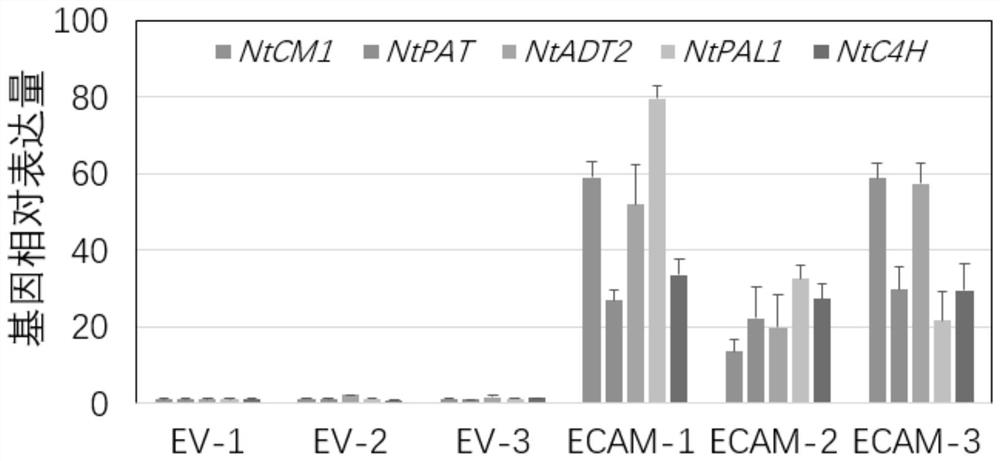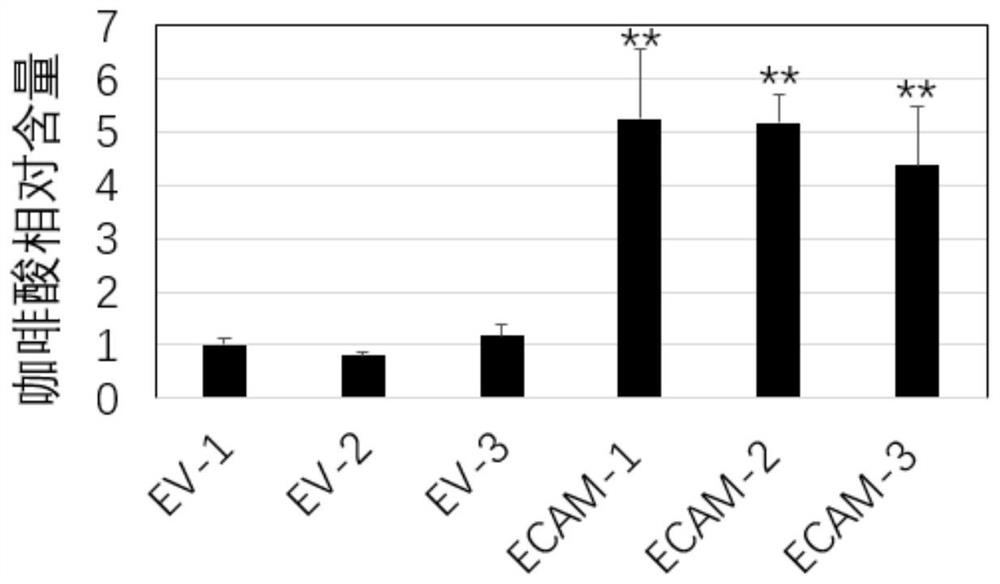Method for improving caffeic acid content and/or biological self-luminous intensity of plant
A technology of self-luminescence and caffeic acid, which is applied in the biological field, can solve the problems of low caffeic acid content and weak luminescence of bio-self-luminous tobacco, and achieve the effect of improving the intensity of self-luminescence
- Summary
- Abstract
- Description
- Claims
- Application Information
AI Technical Summary
Problems solved by technology
Method used
Image
Examples
Embodiment 1
[0049] Example 1 Construction process of enhanced caffeic acid synthesis (eCAS) module vector pYLTAC380GW-7G
[0050] This study used the TransGene Stacking II system for multigene assembly. The NtCM1, NtPAT, NtADT2, NtPAL1, NtC4H genes in the tobacco (Nicotianatabacum) genome corresponding to CDS were amplified. The following tobacco genes NtCM1, NtPAT, NtADT2, NtPAL1, and NtC4H driven by the 35S promoter of tobacco mosaic virus were integrated into the pYLTAC380GW plasmid, and finally connected to remove the selection marker gene expression cassette element through a one-step BP recombination reaction, thereby constituting an enhanced Caffeic acid synthesis pathway vector pYLTAC380GW-NtCM1-NtPAT-NtADT2-NtPAL1-NtC4H (pYLTAC380GW-7G).
[0051] For the sequence information of NtCM1, please refer to the gene accession number: XP_009768497; the sequence information of NtPAT, please refer to the gene accession number: XP_016480150; the sequence information of NtADT2, please refer...
Embodiment 2
[0061] Example 2 Analysis of transient transformation of tobacco leaves with enhanced caffeic acid synthesis (eCAS) module vector
[0062] 1. The EHA105 bacterial solution containing the verified correct vector plasmid pYLTAC380GW-7G was streaked and activated on the LA+Kana+Rif plate, 28°C, 36h, and the colonies were picked from the plate and transferred to LB+Kana+Rif+15μM As medium, 28°C, 200rpm to OD 600 = 0.8-1.0, 4000 rpm, 10 min to collect the cells, suspend the Agrobacterium cells with an infection solution (containing 10 mM MgCl, 10 mM ES, 150 μMAs), and let stand at room temperature for 2-3 h.
[0063] 2. To verify the transient expression in tobacco leaves, use a 1mL needle to gently make a small opening on the surface of the tobacco leaves, and then use the needle tube with the needle removed to absorb the bacterial liquid, and inject it into the leaves from the wound of the tobacco leaves. Indoor normal culture for 48h, and then sample some leaves for relative ex...
Embodiment 3
[0064] Example 3 Analysis of caffeic acid content and luminous intensity in eCAS module transgenic plants mediated by Agrobacterium
[0065] 1. Streak the EHA105 bacterial solution containing the verified correct vector plasmid pYLTAC380GW-7G on the LA+Rif+Kana plate, 28°C, 36h, pick and clone into 3-5ml LB medium at 200rpm, 28°C, 36h , according to the ratio of 1:100-1:50 to expand and cultivate 50ml for 3-5h to OD=0.6, then centrifuge the bacterial liquid, use MS0 liquid medium (MS+3%Sucrose+PH5.8, 50ml) to suspend the bacterial cells to OD=0.6 for infection;
[0066] 2. Select the successfully obtained bioluminescent transgenic tobacco (there is a luminescence-related gene Hisps-CPH-H3H-NPGA-Luz in the genome) seeds, and plant them on sterile MS medium for 4-5 weeks to fully expanded tobacco health Leaves, cut into 0.5cm square size with a scalpel (cut the leaf margins to avoid the main veins), with the upper surface of the leaves facing down in MS1 solid medium (MS+0.5m...
PUM
 Login to View More
Login to View More Abstract
Description
Claims
Application Information
 Login to View More
Login to View More - R&D
- Intellectual Property
- Life Sciences
- Materials
- Tech Scout
- Unparalleled Data Quality
- Higher Quality Content
- 60% Fewer Hallucinations
Browse by: Latest US Patents, China's latest patents, Technical Efficacy Thesaurus, Application Domain, Technology Topic, Popular Technical Reports.
© 2025 PatSnap. All rights reserved.Legal|Privacy policy|Modern Slavery Act Transparency Statement|Sitemap|About US| Contact US: help@patsnap.com



